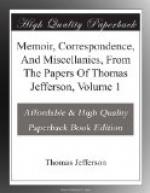The declaration thus signed on the 4th, on paper, was engrossed on parchment, and signed again on the 2nd of August.
[* Some erroneous statements of the proceedings on the Declaration of Independence having got before the public in latter times, Mr. Samuel A. Wells asked explanations of me, which are given in my letter to him of May 12, ’19, before and now again referred to. (See Appendix, note B.) I took notes in my place while these things were going on, and at their close wrote them out in form and with correctness, and from 1 to 7 of the two preceding sheets, are the originals then written; as the two following are of the earlier debates on the Confederation, which I took in like manner.]
* The above note of the author is on a slip of paper, pasted in at the end of the Declaration. Here is also sewed into the MS. a slip of newspaper containing, under the head ‘Declaration of Independence,’ a letter from Thomas Mc’Kean to Messrs. William M’Corkle & Son, dated ’Philadelphia, June 16 1817.’ This letter is to be found in the Port Folio, Sept. 1817, p. 249.
[Illustration: Facsimile of Declaration in Jefferson’s Handwriting—p1]
[Illustration: Facsimile of Declaration in Jefferson’s Handwriting—p2]
[Illustration: Facsimile of Declaration in Jefferson’s Handwriting—p3]
[Illustration: Facsimile of Declaration in Jefferson’s Handwriting—p4]
On Friday, July 12, the committee appointed to draw the articles of Confederation reported them, and on the 22nd, the House resolved themselves into a committee to take them into consideration. On the 30th and 31st of that month, and 1st of the ensuing, those articles were debated which determined the proportion, or quota, of money which each state should furnish to the common treasury, and the manner of voting in Congress. The first of these articles was expressed in the original draught in these words. ’Art. XI. All charges of war and all other expenses that shall be incurred for the common defence, or general welfare, and allowed by the United States assembled, shall be defrayed out of a common treasury, which shall be supplied by the several colonies in proportion to the number of inhabitants of every age, sex, and quality, except Indians not paying taxes, in each colony, a true account-of which, distinguishing the white inhabitants, shall be triennially taken and transmitted to the Assembly of the United States.’
Mr. Chase moved that the quotas should be fixed, not by the number of inhabitants of every condition, but by that of the ‘white inhabitants.’ He admitted that taxation should be always in proportion to property; that this was, in theory, the true rule; but that, from a variety of difficulties, it was a rule which could never be adopted in practice. The value of the property in every state, could never be estimated justly and equally. Some other measures for the wealth of the state must therefore be devised,




